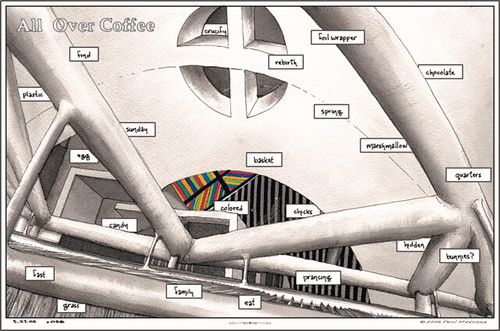
A strip by Paul Madonna, from his "All Over Coffee" series
[Note: This is an essay in progress. Drafts of sections are first posted to my blog, Elsewhere, where readers are invited to leave comments. Sections are then edited and/or rewritten and posted here.
Comments are still welcome. Please leave them in the comments field or by e-mail at gpsullivan AT hotmail DOT com.]
Introduction
In the Introduction to The System of Comics, Thierry Groensteen provides a list of six ways in which comics might bypass a common assumption about a basic requirement of the art form: that of the “permanence, within the panels, of at least one identifiable character.”
Groensteen’s examples (pp. 15-16) make quick work of that assumption. He cites comics with no characters at all; comics from a character's p.o.v.; comics in which the character is consistently obscured, thwarting "characterization"; comics in which the character constantly changes; comics in which multiple characters are indistinguishable from each other; and comics that show a different character or set of characters from one panel to the next.
But he does not address a more basic assumption: that comics need to tell a story at all.
Elsewhere in the book, Groensteen lists a number of non-fictional uses to which comics have been put: autobiography, documentary or non-fiction, and propaganda. Significantly, non-narrative (or non-dramatic) possibilities, such as poetry, are absent from this list.
Poetics—or readings that privilege poetic over narrative resonance—are not, however, absent from his thinking:
“Michael Picard spoke of a poem as a ‘flake of meanings that all analysis flattens in its linearity.’ The same terms can be applied to comics. Standard readings, which privilege, in each image, the enunciable quality, flatten the semantic richness of the image to profit from its immediate narrative function. Only a descriptive reading—attentive, notably, to its graphic quality—and an interpretive reading allows the image to deploy all of its significations and resonances.” (p. 127)
Though he does not use these terms, Groensteen might here be describing two distinct kinds of meaning-making: “causal” (narrative) and “by accrual” (poetic), what avant-garde filmmaker Maya Deren called, in a description of two kinds of structure in film, “horizontal” (or dramatic, “one circumstance – one action – leading to another”) and, alternatively, “vertical” (or “poetic structure”).
Given Groensteen’s emphasis throughout The System of Comics on the panel and the page layout—literally where panels are situated in relationship to others—as primary units of meaning, it’s odd that he spends no time looking at work in comics that might, by design, most fully exploit these primary units: comics wherein the panels and page layouts—or even page-to-page relationships—are not predetermined by narrative arc.

1 comment:
I've just discovered this blog of yours, Gary. I have read Groensteen too, and I take issue with some of his assumptions, but some of them are really useful I think. I would love to keep reading your ideas about this topic.
Post a Comment